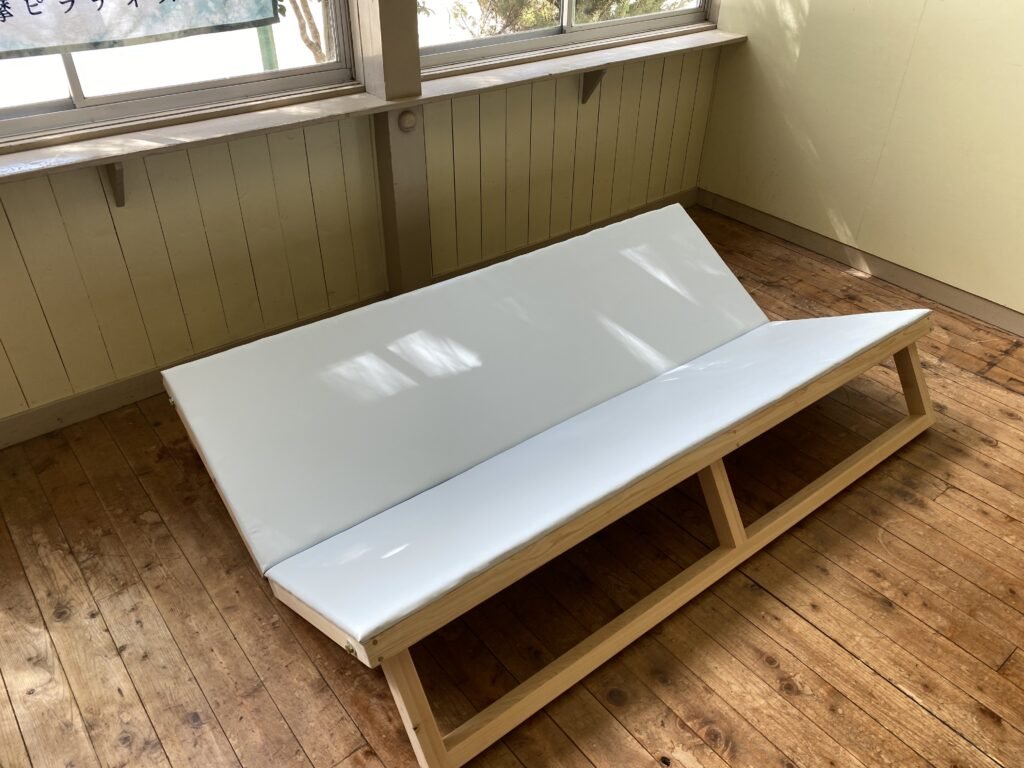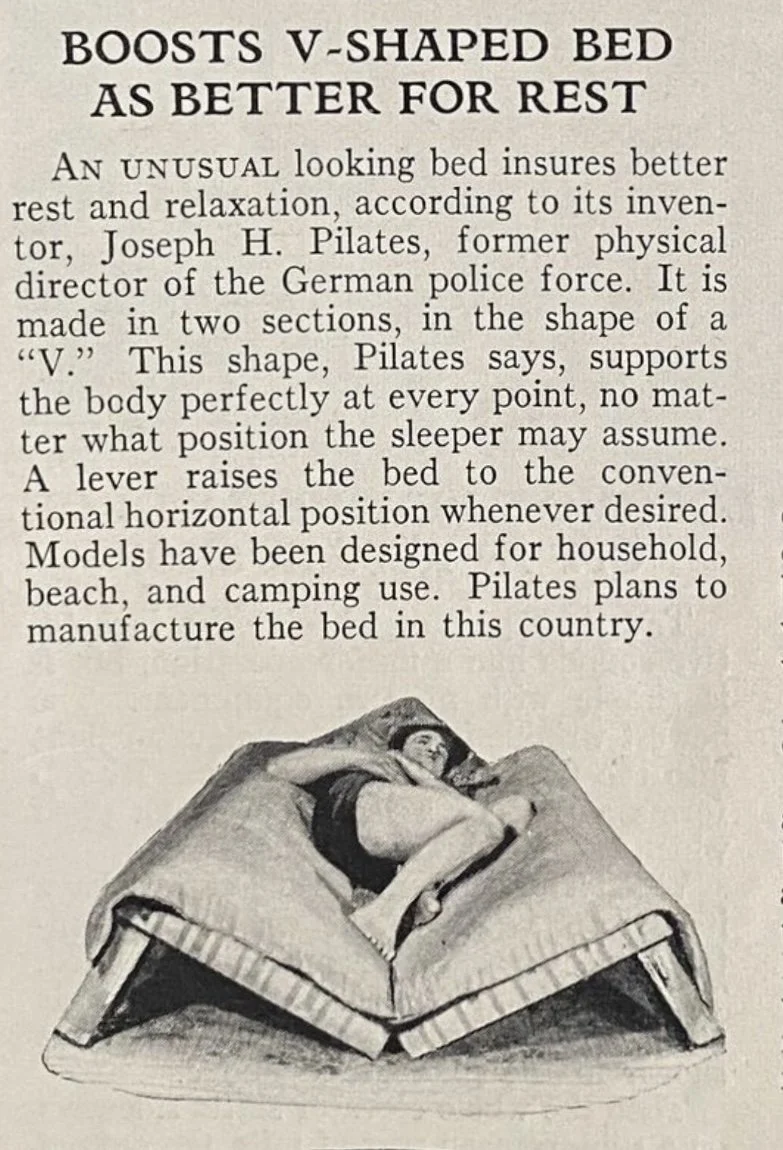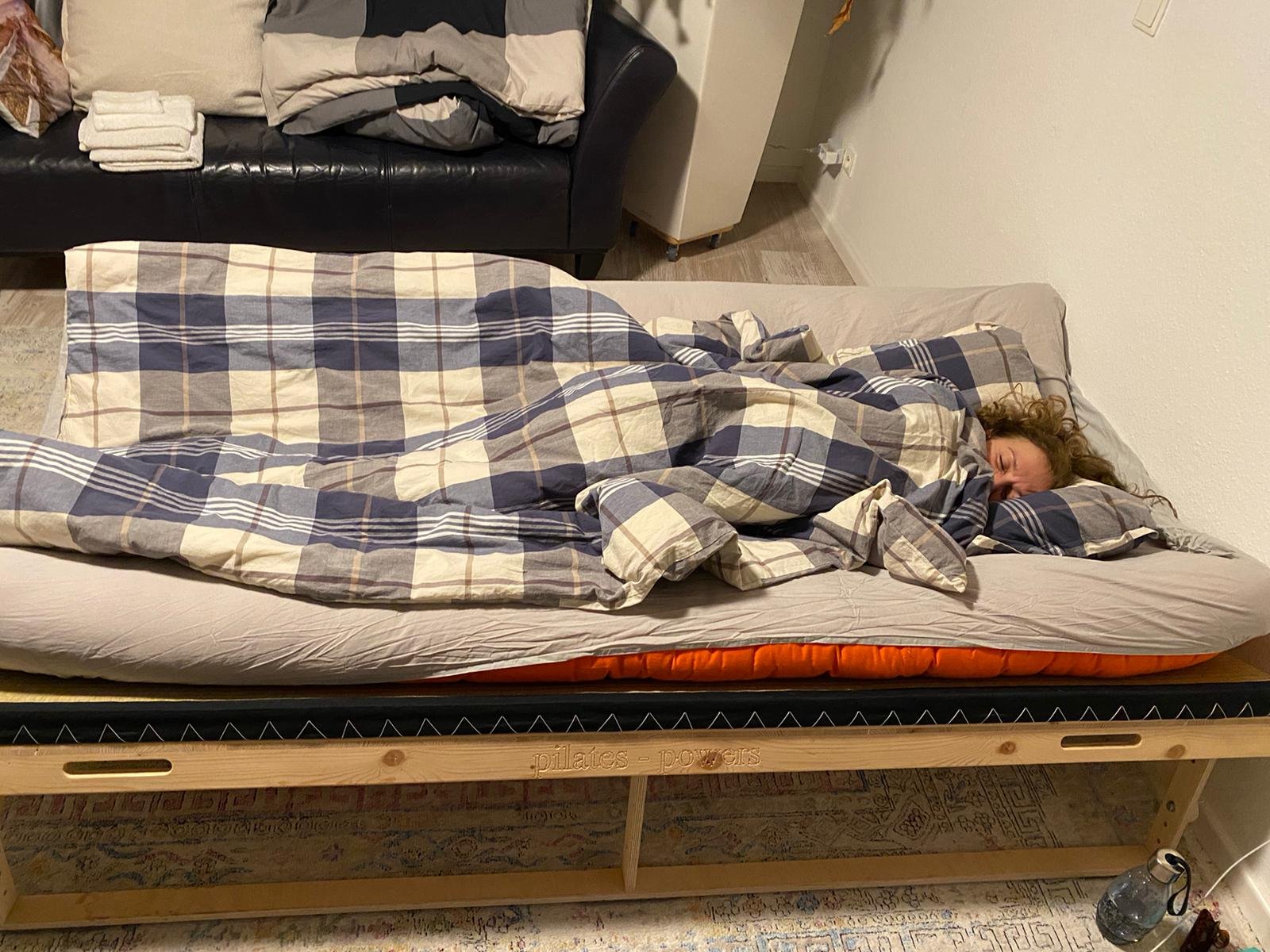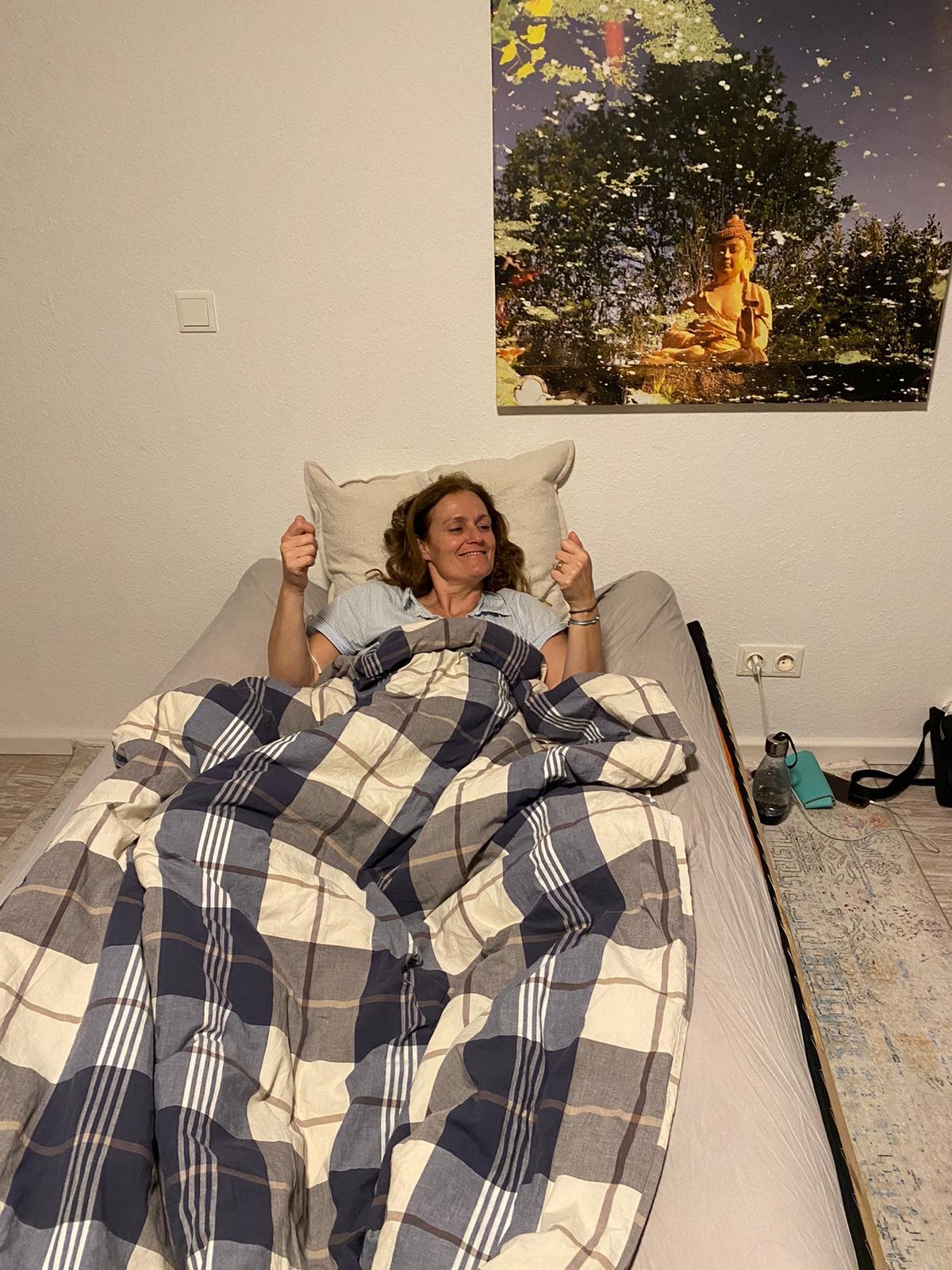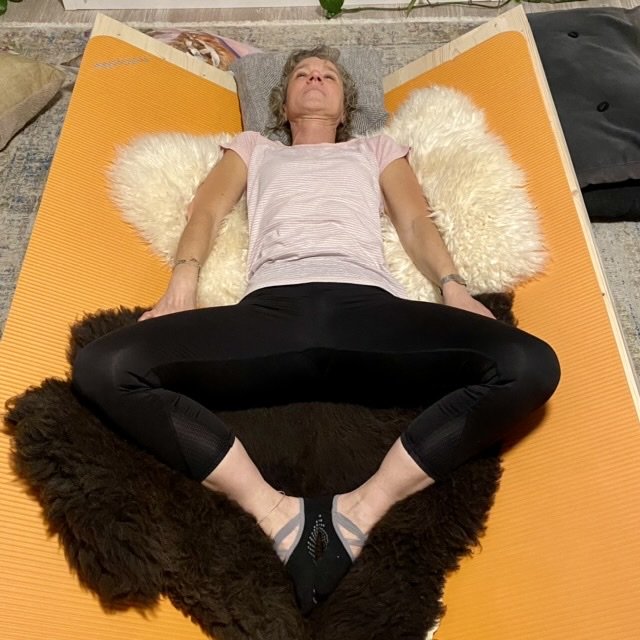The Pilates „V“ Bed
When I started Pilates many years ago, I tried to gather all available information about Joseph Pilates and his inventions. I remember reading the pages of Joseph Pilates' first book, from 1934, "Your Health", where Joseph Pilates described his "Pilates Automatic Balanced Health Furniture" and immediately dismissing it as something from the past. While his chair reminded me of a modern recliner, I was rather irritated at the sight of his V-shaped bed. Can a bed like that even be comfortable?
You can buy most of Joseph Pilates' equipment from at least one manufacturer in the world. But in all this time, I have never come across a manufacturer that sells one of Joseph Pilates' V-bed variants.
Note: Someone told me about OKUTAMAPILATES in Japan after the blog post was published. They sell this version of the bed for 260,000 yen, which is currently equivalent to 1,800 EUR.
Three V-bed variants
There was more than one V-bed model from Joseph Pilates. Because Joseph Pilates continued to refine his equipment.
The first version of Joseph Pilates' V-Bed was a simple wooden construction that was also foldable. Joseph Pilates demonstrated on film how easily it could be transported, and he also showed a short run-through of the different reclining positions on the bed.
Joseph Pilates's second V-bed model was a more bed-like construction, which we can see in his book "Your Health". As far as can be seen from the photos, the V-shaped angle does not appear to have changed from the original.
The final ingenious step was the construction of the Bednasium. A bed that could be switched between the V-shape and a flat surface by moving a lever. The V-shape of the bednasium was used for sleeping and the flat surface for exercising, as Joseph Pilates demonstrated again in a film.
It was also obviously more comfortable as the lying surface was fitted with elasticated straps. I suspect it may have had a certain hammock feel to it. The similarity of Joseph Pilates' V-Bed to hammocks is quite interesting as hammocks have been used for many centuries and their benefits are well documented.
Joseph Pilates advertised the last model as the "Pilates Automatic Posture Correcting and Rejuvenating Bed". It was available from the MIRACLE BED AND CHAIR COMPANY, 368 Alexander Avenue, New York City. It was available in three versions:
As a slatted base to place on your bed frame
As a free-standing bed with a metal frame.
As a bednasium with a half-height tower at the end. This was the version that Joseph Pilates showed in his films and which he proudly presented to IC Rapoport. Rapoport took some iconic photos, including the hilarious picture below, which he took just as a joke for his client at Sport Illustrated. Many thanks to IC Rapoport for permission to use this image).
How did I come into possession of Joe's V-bed?
Fortunately, building this V-bed version is simple in theory, and there is even a detailed plan from Mark J Warhaft.
https://www.pilates-equipment-plans.com/.
The plan for the bed is even free of charge.
I asked our master carpenter Thomas Steeg from Tönisvorst for help. He is simply super and also does extremely creative and specialised carpentry work, such as the complete interior fittings of trailers for circus performers. Perhaps it also helped that Brigitte - his wife - has been doing Pilates with us for 11 years.
Small proof photo: Film shoot 2014 for Pilates & Friends. Brigitte on the far right, next to her from the right Frank, Feli, Reiner and Kerstin Bredehorn.
Thomas Steeg took the plans provided above and worked a little extra magic. In the version he designed, the angle of the V-shape - which is 120 degrees in the original - can be altered to a certain degree, which greatly benefits the comfort of the bed.
121 degrees is very close to Joseph Pilates' original.
130 degrees is the more comfortable version for me.
It can also be easily converted into a flat lying surface, so you have a guest bed that can be easily stowed away for people who don't want to try sleeping on the V-shape.
Here the V-bed unfolded as a flat bed.
In my experience, sleeping on the pure wood as shown by Joseph Pilates in his film was not comfortable enough (Joseph Pilates also used a mattress on the original design, as can be seen in other pictures). I tried out different materials and decided on tatamis. These are mats filled with pressed rice straw, which are five centimetres thick and have a certain springy quality. Tatamis were traditionally used as floor coverings in Japan and, together with futons, formed the original bed frame. Following this Japanese model, I have placed a futon on top of the tatami, which consists of a total of 6 layers of sheep's wool.
Joseph Pilates theory behind the V-bed
I've had the V-bed since February and - shame on me - haven't slept on it that often because it's in my Pilates studio and not at home. When I tried it out, I fell asleep straight away, just like I do at home. I woke up two or three times because my body first had to get used to the new position. Also, turning in the V-bed is a bit more strenuous, so I turned less. Joseph Pilates himself saw this as a special feature of his V-bed, as you can read in his book "Your Health":
Today our public health and research programs do not sufficiently stress the importance due to a profound study of the "laws of mechanics" as applied to the human body. Particularly is this true with reference to a proper consideration and deep study of the necessity for recognition of the importance of the attainment of normal equilibrium of the body in motion, at rest or in sleep. From a strict humanitarian rather from a purely commercial viewpoint, a close and unbiased study of the reasons responsible for the invariable restless tossings experienced by the average sleeper, can lead to but one definite conclusion with reference to our modern beds - i. e., that while admittedly they are appealing to the eye from an esthetic standpoint and apparently seemingly comfortable, they are, however, as a matter of fact, quite unnatural and impractical for the very purposes that they are supposed to have been originally designed. They do not afford maximum rest and complete relaxation. All they do is to afford a place upon which to toss the body. Those beds may look pretty, but they absolutely fail in their aid to rest and health. I have invented a bed that affords both rest and comfort, but the makers of our beautiful beds, will not give my inventions the recognition they deserve, for they fully realize that when this is done, the field of bed manufacturing will be revolutionized. It is, of course, axiomatic that restful sleep is impossible without the fullest and complete relaxation of all our muscles.
Joseph Pilates explains further in his book "Your Health":
Here is the old style bed or the kind almost everyone is using today. The arrow shows the strained position in our present day straight beds. No matter how pretty a bed might be, it cannot and does not give you the comfort and rest of my "V" shape bed. There is nothing but continuous restlessness in the present day bed.
All of the chairs and beds illustrated in this book, were made by myself, from carpentry to upholstery and each model is protected by patents registered with U.S. Patent Office. Strange as it may seem, to those who are not technically informed, beds equipped with even the very finest of wire bed springs, actually defeat this very object. Why? Because the bony structure forming the "foundation" of our body does not in beds so equipped receive the necessary natural resistance to afford the requisite simultaneous relaxation of both the skeletal and muscular systems of the human body. Under these adverse circumstances, the body has, so to speak, literally to snatch rest with its corresponding motion of relaxation "on the fly," as it were. I have taken motion pictures of a person in sleep covering a period of eight hours, and my film, the same of that of the outstanding manufacturer of beds today, records as many as forty-five different changes of position during sleep. In fact, mine showed 48, and his, 45. In my bed, you won't change half a dozen times. While recognizing the fact that we tire either by too little or by much activity - there is a happy medium - not too much and not too little. Is not an average of 55/8 movements an hour during sleep rather excessive for persons supposedly enjoying normal health.
Can the body under such conditions really receive the benefit naturally inherent in proper rest which is implied by minimum rather than maximum changes of position during normal sleep?
And here Joseph Pilates solution.
Joseph Pilates wrote
Here is the author resting comfortably in one of the bed inventions. Note the manner in which he rests - like the cat or the dog in his natural, comfortable position. This is my "V" shape bed and has been specially devised for the child as a bed for correcting faulty posture and perfect relaxation of the spine and the muscles surrounding it. This "V" bed is especially adopted for the expectant mother, who requires all the comfort and rest she can get and also requires a perfect spine. This is the natural bed for the hospital for expectant mothers, asthma sufferers and consumptives.
So much for Joseph Pilates in "Your Health".
How does it feel?
Over the last few months, many of my customers have tried out the V-bed in various lying positions. Almost all of them have immediately realised how comfortable the bed feels, despite its strange appearance. They often said that the bed gives you a certain feeling of security.
On the International Pilates Heritage Congress 2022 in Mönchengladbach, Lolita San Miguel - still trained and certified by Joseph Pilates - tried out the V-.bed. She was thrilled. She had already tried the Bednasium in Joseph Pilates' studio, but didn't like it at the time. But she actually took a nap on my V-bed straight away.
Murielle’s experience with the V-bed
My friend Murielle Pickard-Dellis of https://inneryoupilates.ch tried it out. Here is her report:
I was incredibly lucky to stay at Reiner's studio pilates-powers, and to be able to try out the V bed! I was obviously very happy and excited to be asked to sleep overnight in Joseph Pilates' creation. However, I was a little apprehensive about how well I would sleep all night in this rather atypical bed. First of all I was pleasantly surprised that I could read in this bed with great ease. Then I had absolutely no trouble falling asleep and had an excellent night. I usually sleep on my side and the V-shape of the bed meant that there was much less shoulder compression. I really appreciated having the leg support thanks to the V shape, allowing much better hip alignment. I also found that my spine was more relaxed. I woke up feeling really good in my body and less stiff. And...no risk of falling out of bed! Many thanks Reiner!
Nagi’s experience
And at the same visit also my friend Nagi Takahashi https://instagram.com/nagicia from Japan tested the bed and later wrote on Instagram:
I got to sleep in the V-bed that Reiner presented at the Pilates Heritage Congress last September
Let me share the unique experience.
I turned the lights off and was ready to go to sleep. As l closed my eyes the it felt like I was on a hammock or the womb position when doing antigravity yoga. Interesting, I thought.
After a while I wanted to fall asleep but couldn't- it was like my body was telling me "I've never slept in this shape you know". I don't remember how long I was tossing and turning, but it was fascinating how my body adapted to the V-bed. As I got comfortable, I was able to sleep just fine.
I woke up in the morning, the most naural way to get out of it was doing the Roll Up! How cool is that:) I felt taller when I stood up, it was like gravity did something to my spine.
I realized that the shape is good for the body especially lying on the side because the bottom shoulder and hip sinks into the V. There's also support at the sacrum which gives more snug.
A big thank you to @pilatespowers and I hope I get to try it again!
Here are a few more observations:
When lying on your back in a V-bed
In the V-bed, the spine barely touches the centre part of the bed. This hanging position gives the spine the opportunity to decompress.
Clients with shoulder problems usually feel much more comfortable on the Cadillac when I place small pillows (the height varies) under their shoulders. In the V-bed, the sides of the bed offer this option from the outset. Incidentally, this is an important reason why I felt that the angle of the V-shape needs to be customised. Because if the angle is too steep and you have broader shoulders like me, they would get too much pressure
If you bring your legs into a diamond position, the cheeks support your legs. Very comfortable. A favourite with pilates-powers customers.
Lying on the side in a V-bed
As the two wings of the bed give you support, there is almost no weight on the side and shoulder you are lying on. In the picture Lidija beaming at us.
You can also curl up in the embryo position, which provides additional support and a feeling of "protection". This photo shows this very nicely here. Incidentally, we recorded this when we were still experimenting with different supports.
If you bend your upper leg at a 90°/90° angle, your knee and foot rest comfortably on the side of the V-bed and your upper leg is always parallel to the floor. A position that side sleepers often try to simulate with a thick pillow under the thigh. Very comfortable.
Lying on your stomach in a V-bed
You might think that it is uncomfortable because of the rising sides, but actually it is not, as you are held by the two wings and your chest and stomach are not pressed together.
Lying position half/half
The V-shape gives you endless possibilities of lying half on your side and half on your stomach, or half on your back and half on your stomach, each with different leg positions. They are all very comfortable once you have found your ideal position.
Use as a couch
As you can see, two people can have a nice chat on the V-bed.
How can you experience it for yourself?
Depending on your manual skills, you can try to build it yourself. The plans from Mark J Warhaft help a lot.
You could ask a carpenter but with today's wood prices this can easily cost 1000 EUR or more before you have even ordered tatamis or a futon (another 500 EUR).
For those who just want to try it out, there is a third alternative.
As a pilates-powers customer, simply make an appointment with me and stay in bed in the studio completely free of charge.
If you are a Pilates trainer and are travelling from further away, there is also an option:
Our studio is about 25 kilometres from Joseph Pilates' birthplace. So if you are visiting the birthplace anyway or are otherwise travelling in the Düsseldorf area, feel free to drop by my studio. Just teach an hour in our studio (mini-workshop on your speciality, a private lesson or a group lesson) during the day and you can sleep one night on Joseph Pilates' V-bed. No exchange of money required. Sounds fair?
Please let me know a few days in advance when you would like to come for an absolutely unique sleep experience.
Stay healthy and sleep well!


